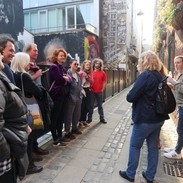Signs for your premises
Photo by: VisitBritain/Sam Barker

Disclaimer
Disclaimer: While every effort has been made to ensure the accuracy of the information contained in the Pink Book, we regret that we cannot be responsible for any errors. The Pink Book contains general information about laws applicable to your business. The information is not advice and should not be treated as such. Read our full disclaimer.
Key facts
If you intend to display any outdoor signs and/or advertisements, you may need to apply to the planning authority for consent.
The need for consent from the planning authority depends on whether signs are fully, partially or non-illuminated and where they are situated.
You will also need to ensure that any signs displayed are not misleading, as this could constitute a breach of unfair trading and misleading marketing legislation.
The highways department of your local authority can advise on brown tourism signs.
Background
Do the regulations apply to me?
Yes: if you display any outdoor signs and/or advertisements, you need to comply with:
- The Town and Country Planning (Control of Advertisements) Regulations 2007;
- The Consumer Protection Regulations 2008 relating to unfair trading and misleading marketing (see the Unfair Trading Practices section).
Planning regulations and permission
The display of all outdoor signs and advertisements is controlled by local planning authorities under the provisions of the Town and Country Planning (Control of Advertisements) Regulations 2007.
Local planning authorities are required to exercise their powers under the regulations with regard to amenity and public safety, taking into account relevant development plan policies in so far as they relate to amenity (including both visual and aural amenity) and public safety, as well as any other relevant factors.
These regulations can be complex, and you are strongly advised to seek the advice of the planning department of your local authority (see Further guidance below) before commissioning and setting up any signs for your premises.
A very brief summary of the regulations is given here:
- ‘Express consent’ means that you have to apply to the planning authority for consent to display the proposed sign.
- ‘Deemed consent’ means that consent is deemed to have been given by the planning authority and you do not have to apply for it.
Signs on your premises
Illuminated and non-illuminated signs
Fully illuminated signs always require express consent from the planning authority (although this is not normally the case if the sign is displayed inside a window, rather than on the wall or doorway outside).
Partially illuminated signs (for example where only letters, and not the background, are illuminated) may not require express consent.
Non-illuminated signs can normally be displayed with deemed consent if they are fixed to the building, although there are limitations placed on the height of the sign and on the size of any characters or symbols on it.
Listed Buildings
If your property is a Listed Building, you will always have to obtain Listed Building consent before you display a sign.
Signs at the entrance to your premises
You may normally put a non-illuminated sign by your gate, driveway or within the grounds of your establishment with deemed consent (subject to limitations on overall size, height and size of characters or symbols).
Signs in advance of your premises
If you wish to put up directional signs by the side of the roads approaching your establishment, for example in a field overlooking the road (with the landowner’s permission, of course), you must always seek the express consent of the planning authority.
Flags
Provided that your premises are not within areas of special control or other areas with protective designations, flag advertisements that do not require express consent are restricted to:
- A single flag from a single flagpole projecting from the premises with either the company name or logo of the company, or the advertising of a specific event of limited duration – such as a sale.
- Two flags on flagstaffs not attached to a building.
Special controls
In sensitive places, for example conservation areas, the deemed consent may be removed by an Article 4 Declaration. You must apply for consent for signs on or at the entrance to your premises. In some rural localities, an Area of Special Control Advertisements may restrict all outdoor advertising.
Ensuring signs are not misleading
You should also ensure that any signs displayed are not misleading. For example, it is illegal for a non-assessed property to display a Quality Grading Scheme sign or to display a sign showing an incorrect rating.
For more information on misleading signs, see the Unfair trading practices section.
Brown tourism signs
Both attractions and accommodation businesses can apply for brown tourism signs. However, in practice, accommodation establishments have been less successful with their applications than visitor attractions.
The first step is to contact the highways department of your local authority, which will advise you about procedures, local policy and the cost of such signs. Each local highways authority has its own guidelines that balance local environmental and road safety interests with those of the tourism industry.
Your local highway authority controls signs on the roads in its area, and sets local policy on brown signs. National Highways controls signs on trunk roads and motorways.
The standard for tourism signing on the trunk road network, and guidance on signage on local roads in England, is available on the National Highways website – along with an application form for signs on roads managed by National Highways. However, it should be noted that the application process can take up to nine months and a sign can be expensive: from £8,000 to £20,000 if it is on a single carriageway, and from £17,000 to £40,000 if it is on a motorway.
Note: guidance on tourist signs has been modified to ensure that priority is given to genuine tourist attractions rather than wider retail, sport or leisure facilities. There has also been a move towards greater transparency in the application process and improving processing times. While this guidance only applies to motorways and trunk roads, local highway authorities will be encouraged to apply similar standards.
Further guidance
Your local authority
For informal advice or to apply for consent for signage on your property, contact the planning department of your local authority.
Outdoor Advertisements and Signs
Outdoor Advertisements and Signs - A Guide for Advertisers can be downloaded from Gov.uk.
Applying for a brown tourism sign
The National Highways website contains a range of guidance publications related to tourism signage on both trunk and non-trunk roads.
Find local support
Your local LVEP/Destination Organisation or your local authority may also be able to advise you on the local situation with brown signs.







